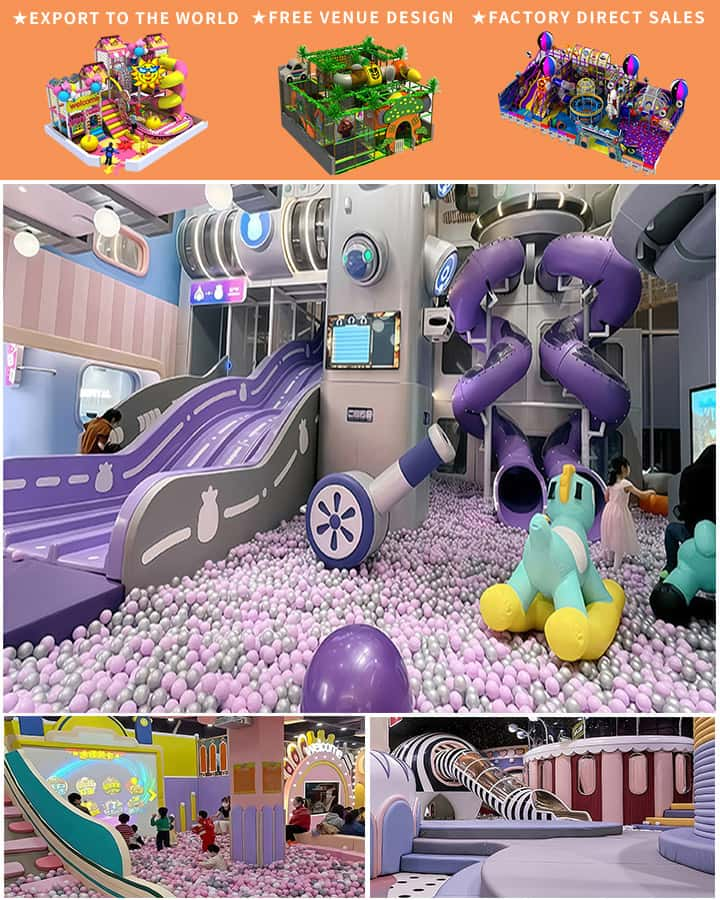Designing an indoor playground for kids can transform a simple space into a magical, fun-filled environment where children can learn, play, and grow. Whether you’re setting up a commercial playground, a home recreation area, or a community center, there are countless elements to consider to ensure safety, engagement, and enjoyment. This guide will take you through the essential steps to create the perfect indoor playground for kids.
1. Planning and Design
The first step in creating an indoor playground is meticulous planning and design. Start by determining the purpose of your playground and who the primary users will be. For younger children, you might want to focus on sensory play and soft structures, while older kids might enjoy more challenging physical activities like obstacle courses and climbing walls.
Sketch out a floor plan that maximizes the available space. Consider incorporating various zones such as:
- Active Play Area: Includes slides, climbing frames, trampolines, and ball pits.
- Creative Play Area: Space for arts and crafts, building blocks, and dress-up corners.
- Quiet Play Area: Bookshelves, reading nooks, and puzzle areas.
- Educational Zone: Interactive games and learning stations that promote cognitive development.

2. Safety First
Ensuring the playground is safe is crucial. Use non-toxic materials and make sure all equipment is age-appropriate and meets safety standards. Soft flooring, such as foam mats or rubber tiles, can cushion falls and prevent injuries. Ensure there’s enough padding under climbing structures and around any hard surfaces.
Regular maintenance checks should be scheduled to inspect for wear and tear. All equipment should be anchored securely to the ground or wall to prevent tipping over. Additionally, supervise young children at all times to ensure they use the equipment correctly.
3. Incorporating Educational Elements
An indoor playground doesn’t have to be just about physical activity; it can also be a hub for learning and creativity. Introduce educational elements such as alphabet puzzles, counting games, or science-themed interactive exhibits. Storytelling sessions, musical instruments, or even simple coding toys can make the playground both fun and intellectually stimulating.
4. Interactive Features
Adding interactive features can elevate the playground from ordinary to extraordinary. Consider installing a touch-sensitive wall with built-in games or a projection system for interactive floor games. Incorporate technology like augmented reality (AR) to blend digital experiences with physical play. These elements can make the playground appealing to kids of all ages and tech-savvy parents alike.
5. Customization and Personalization
Every child is unique, so offering customizable features can make your indoor playground stand out. Allow kids to personalize their play experience with elements like chalk walls, magnetic boards, or craft stations where they can create their own art. Custom-built structures tailored to specific themes—be it pirate ships, fairy-tale castles, or space adventures—can spark imaginative play and storytelling.
6. Inclusive Design
An inclusive playground accommodates children of all abilities. Incorporate wheelchair-accessible swings, sensory-rich areas for kids with autism, and quiet spaces for those who need a break from sensory overload. Consult with organizations that specialize in inclusive design to ensure all children can enjoy and benefit from your playground.
7. Parental Involvement
Finally, consider areas where parents can comfortably engage with their children. Comfortable seating, coffee stations, and observation decks allow parents to relax while keeping an eye on their kids. Host parent-child workshops or events to encourage bonding and make the most of the playground facilities together.
Conclusion
Creating an indoor playground for kids involves thoughtful planning, safety considerations, and creative design. By incorporating educational elements, interactive features, and inclusive designs, you can build a space that not only entertains but also fosters growth and learning. With these guidelines, you’ll be well on your way to designing an indoor playground that brings joy, excitement, and developmental benefits to children of all ages.




